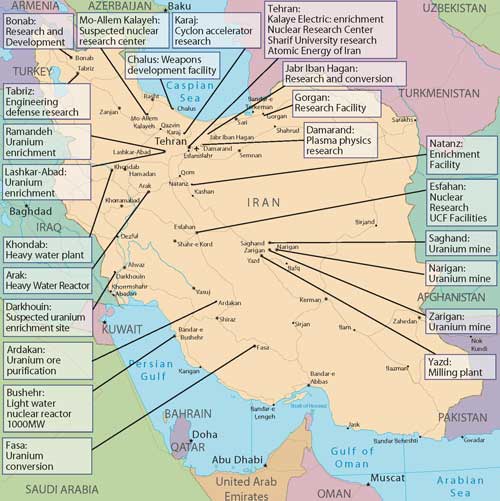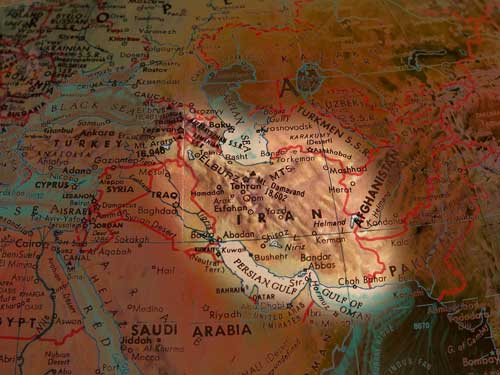08/09/2011 – The Iranian nuclear question was the focus of a panel discussion at the Hudson Institute on July 13. The three nuclear security experts who provided panel presentations offered both overlapping and alternative perspectives and policy prescriptions regarding the Iranian nuclear challenge. They addressed such topics as the threats it poses, the implications for U.S. interests, and the policies available to the United States moving forward.
They all agreed on the importance of keeping the Iranian nuclear program within some bounds short of nuclear weapons possession as well as the value of maintaining a strong military presence in the Middle East to deal with a range of possible contingencies.
Although agreeing on many points, especially the desirability of preventing Iran’s acquisition of nuclear weapons, the three nuclear security experts offered alternative perspectives and prescriptions regarding the Iranian nuclear challenge based on their distinct views regarding the scope and intensity of the threat posed by Iran’s nuclear ambitions.
Dr. Ollie Heinonen brought his considerable technical to bear to elucidate the progress Iran has made in the nuclear arena despite international pressure and sanctions.
Dr. Christopher Ford reviewed the diverse threats a nuclear-armed Iran presents to U.S. interests in the region.
Dr. Peter Jones argued that, while frustrating, negotiating with Iranians over their nuclear program still made sense if reinforced by the use of limited sanctions and clandestine indirect instruments.
Heinonen, a Senior Fellow at the Belfer Center for Science and International Affairs and former Deputy Director General of the International Atomic Energy Agency (IAEA), warned that Iran is continuing to make progress toward developing a nuclear weapons capacity. While Iranian scientists have been engaged in clandestine nuclear activities since the early 1980s, their nuclear program has, after a series of fits and starts, grown disturbingly advanced even after Iranian dissenters exposed in 2002 the secret construction of a large clandestine enrichment plant in Natanz. Since 2003, the IAEA and more recently the UN Security Council have adopted a variety of criticisms and sanctions in a failed effort to secure the program’s suspension.
 (Credit: http://www.nti.org/e_research/profiles_pdfs/Iran/iran_nuclear_sites.pdf)
(Credit: http://www.nti.org/e_research/profiles_pdfs/Iran/iran_nuclear_sites.pdf)
According to Heinonen’s calculations, Iran has by now installed 8,000 IR-1 centrifuges and produced roughly 4,400 kg (9.050 lbs.) of uranium enriched to 3.5% in centrifuges linked in a cascade. Furthermore, 371 tons (818,000 lbs.) of UF6, which serves as feed material for LEU enrichment, has already been produced at a major uranium conversion facility in Esfahan. In February 2010, Iran began enriching LEU to 20%; while suitable for civilian purposes, 20% LEU can be readily augmented to 80% to 90% enrichment for military purposes.
The specter of Iran’s acquiring weapons-grade high-enriched uranium (HEU) rose markedly in June 2011, when Abbasi Davani, the newly appointed President of the Atomic Energy Organization of Iran, announced the transfer of 20% enriched uranium production from Natanz to Fordow.
Built in secrecy until its construction was unveiled in September 2009, Iran says it will use the Fordow facility to triple its production of 20% enriched uranium using more advanced centrifuges than those at Natanz. Overall, Iran is projected to possess 250 kg (or 500 lbs.) of 20% enriched uranium by the end of 2012. Tripling its production rate at Fordow will require 120 kg (250 lbs.) of 3.5% enriched UF6, which is comparable to Natanz’s extant production levels.
The production of 20% enriched uranium, justified as fuel for the Tehran Research Reactor, is especially dangerous because:
1) It cannot be used to generate electricity (like 3.5% enriched uranium, which is used in most civilian nuclear power reactors);
2) It can be used to make fissile material for nuclear weapons if further enriched and converted; and
3) Iran’s current let alone planned production rate of 20% enriched uranium far exceeds the requirements for fueling the Tehran Research Reactor.
Iran could easily import the 20% uranium needed for this reactor, including that downgraded by Russia’s excess stocks of HEU extracted from dismantled Soviet-era nuclear warheads, so its decision to produce so much 20% enriched uranium raises suspicions that the Iranian government is seeking the material foundation to rapidly establish a nuclear weapons program should it decide to do so.
Heinonen further noted that Iran had announced plans to construct up to 10 additional uranium enrichment sites, but has not met its obligation to provide the IAEA with information about their intended location and other details. Further complicating matters is the Iranians’ progress on its heavy water reactor which, by 2014, will be capable of producing enough weapons-grade plutonium to make one nuclear weapon per year.
Finally, Iran has failed to address IAEA concerns over alleged studies by Iranians regarding the use of nuclear power for military purposes. These alleged studies allegedly address such topics as special neutron sources without civilian applications, high explosives with precise timing, and missile re-entry vehicles that can carry nuclear warheads.
If Iranian military entities are engaged in nuclear-related research, the Islamic Republic would be violating its commitment under the Nuclear Non-Proliferation Treaty to use nuclear technologies exclusively for peaceful purposes.
In light of Iran’s continued progress and defiance of international demands that Iran suspend its sensitive nuclear activities pending clarification of possible research involving nuclear weapons, Heinonen called on the international community to increase its pressure on member states to provide information on Iran’s proliferation activities. He further called on the world’s governments to step up enforcement of the UN Security Council sanctions resolutions.
Christopher Ford, Senior Fellow and Director of the Hudson Institute Center for Technology and Global Security, and former U.S. Special Representative for Nuclear Nonproliferation, warned that Iran’s nuclear activities were placing several key U.S. national security interests at risk, including:
1) Preventing a nuclear attack against the United States or its allies
2) Keeping terrorists from acquiring nuclear materials or technologies
3) Preventing Iran from dominating the Middle East
4) Averting further cascading nuclear proliferation in the Middle East
5) Promoting peace in the Middle East
6) Upholding the strength of the global nuclear nonproliferation regime
7) Preserving the reputation of the United States as a strong and effective ally
8) Decreasing risks that the Iranian government can exploit the Arab Spring for nefarious purposes
According to Ford, Iranian leaders want to acquire nuclear weapons to intimidate other countries, “immunize” Iran against outside military intervention; and for reasons of status and prestige. In highlighting the difficulties of ascertaining Iranian intentions in the face of its saber-rattling rhetoric, Ford warned that one couldn’t exclude the possibility of an Iranian nuclear attack. While the regime itself could perhaps be dissuaded or deterred by U.S. threats, our paucity of knowledge vis-à-vis Iran’s likely command, control, and communications (C3) system leaves unresolved the risks of an inadvertent or unauthorized strike.
Ford also underscored the danger inherent in the powerful and extremist Iranian Revolutionary Guard Corps (IRGC) having responsibility of Iranian nuclear weapons stewardship given the uncertainty of Iran’s political situation as well as the IRGC’s radicalization and ability to defy Iranian political leaders. In this context, Ford noted that the Arab Spring offers Iran both an opportunity and a threat. The wave of upheavals offers the prospect of the demise of some regimes Tehran opposes, but the repressive clerical regime would be threatened if democratic forces in the Middle East gained strength.
Another key U.S. interest is preventing terrorists’ acquisition of nuclear weapons, nuclear materials, and technological know-how from Iran. While the Iranian regime may prize its survival too much to launch a nuclear attack, according to Ford it is conceivable that Iranians could—knowingly or accidentally, given the program’s scope—enable one or more terrorist proxies to acquire its nuclear assets in such a way as to claim deniability. Moreover, Iran’s extensive “black” and “grey” market ties, currently used to circumvent international sanctions and acquire items required to support Iran’s expanding nuclear program, creates a “spider web” of illicit transnational transactions that could see “cross-pollination” between otherwise disparate networks, possibly including the reverse flow of Iranian nuclear technologies and materials to terrorists.
Due to Iran’s unwelcome progress in developing nuclear weapons, Ford concluded that the Iranian nuclear issue is evolving from one of preventing nuclear weapons proliferation to one of mitigating the adverse consequences of a radical Iranian regime possessing growing nuclear weapons potential.
Ford explained that effective mitigation requires ensuring that Iran does not become excessively emboldened by its nuclear advances and that other aspiring nuclear weapons states are not inspired by Iran’s achievements to pursue their own ambitions. The latter policy implies deterring Iran from using or transferring nuclear weapons, material, or technology. It also involves ensuring that Iran does not feel “immunized” from punishment for regional provocations and aggression by sending the appropriate signals to Iran and other states seeking nuclear weapons illicitly. One possible means to this end was by reinforcing the U.S. military presence in the region.
Peter Jones, Associate Professor at the University of Ottawa and former Senior Analyst for the Security and Intelligence Secretariat of the Privy Council of Canada, identified four options most readily available to the Western powers: military action; economic sanctions; indirect disruptive activities; and diplomacy. Jones argued that economic sanctions, diplomatic engagement, and clandestine operations would, in combination, most likely yield the best results.
Jones warned that a pre-emptive military strike against the Iranian nuclear program would be unlikely to end Iran’s nuclear program. Heinonen had already noted that its immense size and clandestine nature would make it difficult to identify and destroy all the relevant targets.
Jones believed even an attempted military strike would prove counterproductive by driving the program further underground, strengthen the unpopular Iranian regime, end its already constrained cooperation with the IAEA, and prove difficult for the United States to sustain diplomatically or domestically.
Still, some experts in the audience considered it useful to retain the military option, noting that F-22/35 airstrikes combined with missile defenses could mitigate considerable damage under some scenarios.
Although Jones favored continuing with the economic sanctions, he warned that the timeline in which sanctions could be agreed upon and implemented could not keep pace with the more rapid schedule of Iranian nuclear weapons development. Even after they are implemented, the sanctions hurt Iran but not enough to compel Tehran to cease its uranium enrichment activities. China would oppose the only sanctions that might truly bring Iran to its knees—boycotting its oil industry.
Jones did advocate pursuing indirect actions that disrupt Iran’s nuclear activities as a means to delay its progress and raise its costs. These clandestine means include assassinating Iranian nuclear scientists, infecting the computers supporting Iran’s nuclear activities with malicious software, and other covert attacks. But he cautioned that these indirect actions by themselves would not stop Iran’s nuclear program.
Jones was more optimistic than the other two speakers regarding the possibility of achieving a diplomatic agreement with the Iranian government to limit its nuclear activities and capacities. Having visited Iran many times, Jones acknowledged that haggling with the Iranians can be very frustrating and slow, but he considered diplomacy an essential component of any approach toward constraining Iran’s nuclear program.
Even so, Jones warned that removing the present regime would not guarantee the emergence of a successor government with nuclear policies more advantageous to Western interests. Many Iranians see possessing nuclear weapons as a rational security instrument given their country’s geopolitical position and history.
Given the limited effectiveness of these options, even in combination, Jones argued that the West may have to accept some degree of uranium enrichment capacity since Iran was unlikely to surrender its hard-won progress in this area. Western countries should find an Iranian nuclear program that they can live with and identify ways to contain it within those bounds.
Jones concluded that a combination of diplomacy, sanctions, and indirect actions would work best though not very satisfactorily in constraining Iran’s nuclear progress. Jones and the other speakers agreed that it was also important to raise the costs the Iranian regime pays for developing nuclear technologies with potential military applications to discourage other governments from pursuing similar policies.


